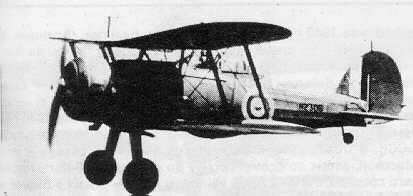The Internet Museum of World War II Aviation | home
Great Britain | Blackburn Roc | Firebrand | Defiant | Beaufighter | Mosquito | Fairey Firefly | Fairey Fulmar | Gladiator | Gloster Meteor | Hawker Hurricane | Hawker Tempest | Hawker Typhoon | Spitfire
Gloster Gladiator
When the Gloster Gladiator was withdrawn from service in mid-WW2, the long era of biplane fighters in the RAF came to an end. It was one of three biplane fighters in WW2 to make a significant difference in the conflict, among the Fiat Cr 42 Falco and Polikarpov I-15. For a biplane it was late in development and did not fly until Sept. 1934. Several were ordered by the RAF, and upon the first of them being delivered, several more were subsequently ordered until early 1940, when the Hurricane had taken the Gladiators place as front line fighter. But despite being supposedly far outclassed by other fighters by the start of World War Two, the outstanding service record of this fighter speaks for itself. In fact, during the siege of Malta, four Gloster Gladiators managed to repel wave after wave of German and Italian bombers, until escort fighters en masse were sent along with the bombers to eliminate the pesky biplanes once and for all.
Usual Pre-War armament was four .30--calibre machine guns, and power was provided by an 840hp Mercury radial. Most of the Gloster Gladiators had enclosed cockpits by the start of the war, although some, especially in foreign service, were still of the open cockpit type. Maneuverability was phenomenal, mainly because of its biplane configuration. But for this maneuverability, speed was lost and it was a lucky day when a Gladiator would exceed 260mph. As more modern British fighters were developed, like the Hurricane and Spitfire, the Gladiators were sold off piecemeal to various nations, including Sweeden, Denmark, Norway, Finland, China, Greece, Ireland, France, Latavia, Lithuania, Belgium, and Russia. It is thought that possibly some Finnish Gloster Gladiators might have fought against some Russian ones, but this cannot be easily proved.
Only one squadron of Gladiators were in action in the Battle of Britain, and their contributions were limited during the action there. Probably the most famous action that the Gladiator fought in was the aforementioned siege of Malta. Five Gladiators were at Malta when the siege began, and two of them were held in reserve. The other three, nicknamed Faith, Hope, and Charity, fought with dogged aggressiveness against the Regina Aeronautica for 18 days of intense aerial action, all three of them surviving at least until the arrival of some Hawker Hurricanes. Due to the lack of parts, ill-fitting engines (Mercury XVs) and propellers from meduim bombers were used in desperation. One of the three Gladiators still exists, left where it was abandoned in Malta after being stripped of nearly every usable part. Today, it has been stripped even more by tourists wanting a piece of history, and has since been blocked off and set up as an exhibit.
Type: Single Seat Fighter
Engine: One 900hp Bristol Mercury IX 9-cylinder radial engine
Performance: Max Speed 253mph; climb to 5000 feet 1.9 minutes
Armament: Varied greatly, usually four .303-calibre machine guns
